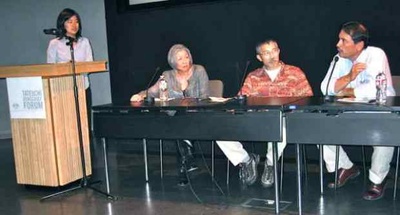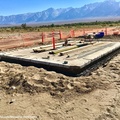Panelists representing the Manzanar and Tule Lake Pilgrimages, along with students, primarily from the University of California, Los Angeles, discussed the origins, history and future of both pilgrimages during Community Builders: Japanese American Activism, 1960-1980 (Part 1), an event sponsored by the Japanese American National Museum (JANM) on October 8.
The panelists included California Assemblymember Warren Furutani, Bruce Embrey, Co-Chair of the Manzanar Committee, and Stan Shikuma and Barbara Takei, both with the Tule Lake Committee.
After concentrating mostly on the origins and history of each pilgrimage (see Panel Looks At Past, Present And Future Of Manzanar And Tule Lake Pilgrimages During JANM Event), the focus shifted towards the future.
With the Manzanar Pilgrimage entering its 43rd year, and with the Tule Lake Pilgrimage now 37 years old, panelists grappled with question of what role the two pilgrimages will play in the Japanese American community, not to mention society in general, and what lies ahead for both long-standing traditions.
One challenge facing the Tule Lake Pilgrimage is finding a way to allow more people to participate.
“We travel together on the buses, and the buses, in a sense, form communities, spending four days together, processing, sharing stories, getting to know people,” said Takei, a Sansei from Sacramento, California, whose mother was incarcerated at Tule Lake before it became a segregation center, as well as at the Amache camp. “I think this is the thing about the Tule Lake Pilgrimage. When you’re traveling together, eating your meals together, you’re living together in the dorms, and going and visiting the site together, there’s a lot of sharing that goes on, and I think that is one of the very powerful parts of the experience.”
“But we can’t accommodate the numbers that [attend] the Manzanar Pilgrimage, which is usually over 1,000 people,” added Takei. “That’s the thing that we’re looking at in the future, trying to find ways to accommodate more people, because the healing process continues.”
Takei, who co-authored, Tule Lake Revisited: A Brief History and Guide to the Tule Lake Internment Camp Site, with Judy Tachibana in 2001, also stressed that the pilgrimages should always shine a bright spotlight on addressing injustices, and not only those facing Japanese Americans.
“The story of wartime incarceration is such a powerful story of the violation of civil rights that all Americans should care about it,” she noted. “Those of us who have family members who experienced it have the opportunity, that personal connection, to share that story, and to find ways to connect the Japanese American story to other stories, incidents and events in social justice.”
“One of the worst parts of the experience for our family members was the sense of isolation, that they were removed, and no one really cared, no one reached out,” she added. “The only group that reached out were the Quakers. In hindsight, we can look back and see the terrible pain that isolation caused. Perhaps we’ll be in a better position to respond when others civil, or other kinds of injustice.”
Embrey emphasized that the Japanese American community has a special responsibility to speak out against injustice.
Students are the ones who really started the pilgrimages, both Tule Lake and Manzanar. When we did that, it’s not like we had all the answers. We were searching for answers. Sometimes, we were just searching for the right questions. But we were willing to take action, and that’s really important, I can’t stress enough how important is it to not be satisfied with just studying the question and saying, ‘hey, that’s not right,’ but going out and doing something [about it]. — Stan Shikuma
“Our community has a unique place in American History, and you can say that Native Americans do too, because, in many ways, reservations were concentration camps,” Embrey stressed. “But our community, as a whole, not just those who were in camp, has a special responsibility to ensure that this country, the broader public, understands what happened on its soil, understands how far the government went to violate our Constitution, and understands the profound economic, psychological—the social dislocation that this act—how it impacted an entire community.”
“We occupy a special place in history, and in this country,” Embrey added. “It is incumbent upon us—actually, we have a responsibility to continue to educate, and continue to bring up the issues of Constitutional rights. This is an ongoing issue that can erupt at any time.”
Historically speaking, what Embrey and Takei described above are what both pilgrimages have been all about since their beginnings in 1969 (Manzanar) and 1975 (Tule Lake).
“Once somebody goes to one of these pilgrimages, it’s a profound transformation,” Embrey noted. “I had an African American reporter come up to me [at one of the recent Manzanar Pilgrimages] and she burst into tears. These are not little vacations, or tours of a historic site. You’re looking at ruins, but they have a profound psychological impact.”
“You’ve got to get people to go, and you have to educate people about what happened,” Embrey added. “This isn’t something that’s easily absorbed. It was very difficult to even get people to talk about it. For decades, people didn’t talk about it, and it took decades for people to come to grips with the camp experience, and to [begin to] heal.”
“The healing process still has to go on. It has had an impact on our community to this day. The Yonsei and Gosei need to understand that it has impacted their families, and their own lives. There is an indirect, empathetic quality that’s very powerful. But there’s also the direct question of how does this relate to some of the struggles going on today, some of the struggles that I face. You have to get people to go to these pilgrimages. It’s incumbent on you, it’s incumbent upon us, to try to draw these lessons for people, and urge them to get involved.”
Beyond The Pilgrimages: Getting Involved
“The pilgrimages are very powerful, spiritual experiences, and are really touchstones for who we are, said Takei. “It’s a very emotionally deep experience. But from there, then what? After the pilgrimage, how do you then integrate it into your life?”
Takei’s question goes to the core of what the two pilgrimages are all about…educating and empowering people so that they can act.
One such issue is the current movement to use appropriate, non-euphemistic language when referring to the camps and the camp experience.
“There’s a debate on how we’re going to talk about the camps,” said Shikuma, who became involved with the Tule Lake Committee in 1978, as a member of the Asian Student Union at the University of California, Berkeley. “Are they going to be presented as ‘relocation centers,’ as the government’s propaganda portrayed it in 1942, or are they going to be called ‘concentration camps’ that the United States set up for its own citizens? You can get involved in that debate. It’s going on right now.”
“Much of the language that we’ve been using to talk about the camps is the language of the oppressor,” Takei explained. “It’s the language of the WRA [War Relocation Authority]. The purpose of that language was to hide and minimize what was going on.”
Shikuma then issued a challenge to the students.
“As students, you’re in institutions of higher education, you’re in a learning situation, so, start by educating yourselves,” he stressed. “You can’t help other people if you don’t know what’s going on. Once you start down that path, help educate others. You can put on educational program, go on the pilgrimages.”
“Students are the ones who really started the pilgrimages, both Tule Lake and Manzanar,” he added. “When we did that, it’s not like we had all the answers. We were searching for answers. Sometimes, we were just searching for the right questions. But we were willing to take action, and that’s really important, I can’t stress enough how important is it to not be satisfied with just studying the question and saying, ‘hey, that’s not right,’ but going out and doing something [about it].”
“I would encourage all of you to try to have an impact on the world.”
Although the UCLA Nikkei Student Union (NSU) moderated the discussions, they seemed to get much more out of the event than they put into it.
“My grandparents, one was in Amache, and I think she moved around [to at least one other camp],” said Sacramento native Alyssa Matsuo, a twenty-year-old Biology major at UCLA, and a member of NSU. “My grandfather was in the [United States] Army, so they had to write letters back and forth.”
“One of my uncles was in Tule Lake, so I had family there, but I haven’t heard much about Tule Lake or Manzanar, because I didn’t have family at Manzanar,” added Matsuo. “I didn’t know there was a jail at Tule Lake. I didn’t know about the Tule Lake Pilgrimage at all. I think that would be an interesting one to go to, since it’s different from all the other ones.”
“I really want to have the first-hand experience. I’ve heard stories through my grandmother’s experiences, so I guess I want to learn more. I would like to go [to the Manzanar Pilgrimage] this year, if I can, just so I can get that first-hand experience.”
NSU President Matt Ichinose also had a family member behind the barbed wire at Tule Lake.
“I enjoyed listening to the presentations about Tule Lake, because my grandfather was incarcerated there, so I have a family attachment to that,” he said. “I enjoyed hearing about what they do at their pilgrimage.”
“Because we’re always involved with the Manzanar Pilgrimage every year, it’s important to know how much we can learn from the panelists, and how NSU can go forward in terms of its involvement with the Manzanar Pilgrimage,” he added. “For our organization, it was a good chance to hear about a different pilgrimage, because all we hear about is the Manzanar Pilgrimage, because that’s the one we go to. Hopefully, this will spur interest in the other pilgrimages as well.”

UCLA Nikkei Student Union member Hiromi Aoyama (at left, behind podium) was one of the students moderating the discussion with panelists (from left) Barbara Takei, Stan Shikuma, and Bruce Embrey. Photo: Gann Matsuda
Turning The Tables
Although the program began as a traditional event where the audience listened to the remarks made by the panelists, it took an abrupt turn.
Indeed, the focus suddenly shifted from the panelists to the students, who suddenly found themselves on the receiving end of questions from the panelists about how they learned about the camp experience, their experiences at the Manzanar Pilgrimage, how they deal with questions of identity and race, and more.
Although this kind of dialogue between the panelists and students was not part of the original plan, the event turned out to be exactly what JANM organizers had hoped for.
“I really wanted to tell the Japanese American story, the history of the story, and not just talk about the past, but how we could learn from past mistakes, and that we could talk about the community in the future,” said Koji Steven Sakai, Manager of Public Programs at JANM. “What I didn’t want it to be was everyone talking about the history, just reminiscing, and going over the same details, over and over.”
“What I really wanted was the students to be able to learn something, and get something out of it,” added Sakai, who served as the primary organizer of the event. “As they think about our community going forward, the Yonsei, the Gosei, and all the generations after that, I want them to think about what they can learn from the Sansei, how they can use those lessons, and continue the Japanese American community.”
The students were taken by surprise.
“I was actually surprised about that,” said Ichinose. “I thought it was going to be more about them talking about their experiences, and the history behind the pilgrimages. But it ended up being more interactive between the students and the panelists.”
“It was a very good way to interact with the panelists, to become more a part of the event, to share our perspectives and find out what they think about our views about the pilgrimages,” added Ichinose.
The spotlight that shined so brightly on the students served to illuminate much more than their views on the camp experience and the pilgrimages.
I think a lot of community organizations are struggling with the question of how to carry on to the next generation. I feel like the only way we can move forward as a community and get the young people involved is to actually involve them, to ask them questions, and really hear what they have to say. — Koji Steven Sakai
“We could’ve had a fine program with the panelists we had, with what they were talking about in terms of what was going on, historically, and why the pilgrimages are important,” said emcee Chris Komai, JANM’s Public Information Officer. “But that other aspect of why this issue is still relevant today, especially with young people—that’s the ultimate question for all of our Japanese American organizations.”
“If the young people in our community aren’t interested in these kinds of things, what’s going to happen to all of our organizations,” added Komai. “The fact that we found so many of them, and so many of them who expressed, in such a very fine way, their feelings, is something that makes me very hopeful for the future.”
Involving the younger generations in a manner in which they feel that they are respected and valued has been a mostly overwhelming challenge for Japanese American community organizations for many years—many have failed to bridge the generation gap, let alone attempt to do so.
“Even though there’s a lot of community organizations, and a lot of people want to involve Yonsei and Gosei, I think they want to involve them [in terms of the] Sansei telling the Yonsei and Gosei about themselves, or about what happened in the past, but [the communication] doesn’t go back the other way,” said Sakai.
“I think a lot of organizations are talking about involving the younger generations, and having their voices in there,” added Sakai. “From my perspective, I’m relatively young, 34 years old. I tend to be the youngest person, and I know there are a lot more younger people who have totally different experiences than I’ve had. I just feel, as a community, like we’re not listening, and we don’t want to listen. We just want to tell.”
“I felt like it might be an interesting change to see what the Yonsei and Gosei had to say, or what the shin-Issei had to say. In fact, to hear what the shin-Issei had to say was really interesting, and I thought, worked out the best in the whole program.”
Komai noted the importance of engaging young people in dialogue and respecting them and their views, rather than just talking and expecting them to be glued to every word.
“I think that’s something that, educationally, is really good, because, the thing is, if you really want to get people involved, you really need to ask them ‘why,’” he noted. “You need to find out what interests them. If you just try to lecture them, if you just try to force feed them everything, just from my own experience as a student, that doesn’t work.”
“But if you’re suddenly taking an interest in me [as a student], and asking me what is my story, what is my background, why would I be interested in the story in the first place, I think that opens it up, and we have two-way communication, and I think this program worked very well along those lines,” he added.
“I think a lot of community organizations are struggling with the question of how to carry on to the next generation,” Sakai emphasized. “I feel like the only way we can move forward as a community and get the young people involved is to actually involve them, to ask them questions, and really hear what they have to say.”
One interested party would love to involve students, but not quite in the way Sakai has in mind. Nevertheless, the experience would be invaluable.
Les Inafuku, Superintendent of the Manzanar National Historic Site, was in Los Angeles for the event, and, having seen these students in action over the years at the Manzanar At Dusk program, he sees an untapped resource, not to mention a relationship that would be mutually beneficial.
Indeed, Inafuku said that the site has research, on-site development work (historic/archeological sites within their boundaries), and many more tasks that he cannot place on the shoulders of his already overworked staff.
“It’s hard to say with the federal budget, not knowing where we are—maybe our partners can help us with funding for student interns, right on site, or, it could be worked out that it could be time spent here in Los Angeles, and time at Manzanar to work on projects,” said Inafuku. “We’ve got lots of research needs. Then there’s social networking. We don’t have time for it, and we could certainly use help with that.”
But Inafuku is also looking beyond internships. Indeed, he is hoping students, especially Japanese Americans, will consider working full-time for the National Park Service, especially at Manzanar, after graduating.
“Asian Americans are very underrepresented within the National Park Service, and we really need to have more,” he noted. “I think it’s a shame that I’m the first Nikkei employee at Manzanar National Historic Site.”
For those counting, Manzanar National Historic Site was established by an act of Congress on March 3, 1992.
“We have Caucasians who are interpreting Nikkei history to the American public, and to people throughout the world. They’re doing a great job, but they would do a better job if there were Nikkei on staff from whom they could learn even more.”
Unattributed views expressed in this story are those of the author, and are not necessarily those of the Manzanar Committee.
*This article was originally published on October 12, 2011 on the Official Blog of the Manzanar Committee.
© 2011 Gann Matsuda






